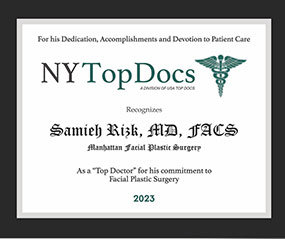Understanding the Flat Nose
A flat nose is a condition where the nose appears flattened or less pronounced due to reduced height of the nasal bridge. This feature is commonly attributed to genetic factors and is often seen in certain ethnic groups as a normal anatomical variation. However, other causes can include trauma, congenital defects, or medical conditions such as cleft palate or certain syndromes.
A flat nose may affect facial balance and harmony, sometimes leading to functional issues like impaired nasal breathing. While the condition is not inherently problematic, some individuals seek correction for aesthetic or functional purposes. Dr. Rizk’s rhinoplasty treatments often involve specialized surgical techniques to enhance the nasal bridge while preserving the natural ethnic features and achieving a more proportionate, harmonious appearance.

What Are The Main Symptoms Of a Flat Nasal Bridge?
The anatomy of a flat nose typically involves a combination of cartilage and bone structures that are less prominent than in other nose shapes. The nasal bridge, formed by the nasal bones and upper lateral cartilages, may be lower, contributing to the flat appearance. Additionally, the septal and tip cartilages, responsible for the nose’s projection and shape, may be less defined.
Aesthetic Symptoms
- The nose appears flattened or less pronounced.
- The nose may look wider, especially at the base.
- A lack of nasal height can disrupt overall facial harmony.
- The nose may lack definition or a refined shape, which some individuals find unappealing.
Functional Symptoms
- Reduced nasal height or structural irregularities can lead to nasal obstruction causing breathing difficulties.
- The flattened structure may contribute to nasal congestion and airflow issues.
- In severe cases, the condition may exacerbate breathing challenges during sleep.
What Causes Flat Nose Bridge?
The cause of a flat nose is primarily genetic, rooted in the hereditary traits passed down through generations. Environmental factors and certain health conditions during developmental stages can also play a role in shaping the nasal structure. In some cases, trauma or injury may contribute to a flatter nose appearance. Understanding these causes is crucial in appreciating the uniqueness of a flat nose and the considerations involved in its aesthetic enhancement.
Genetic Factors
Flat nose is often hereditary, commonly found in certain ethnic groups as a normal variation in nasal structure.
Trauma or Injury
Nasal injuries, especially in childhood, can disrupt cartilage or bone development, leading to a flattened appearance of the nose.
Congenital Conditions
Conditions like cleft palate or genetic syndromes such as Down syndrome frequently include flat nose as part of their features.
Medical Conditions
Diseases like rickets, which affect bone and cartilage development, can result in a reduced nasal bridge and flattened nose.
Surgical or Developmental Issues
Improper healing after nasal surgeries or abnormalities during facial growth can contribute to a flattened nasal bridge and structure.
Long-term Solutions For a Flat Nose in NYC
Augmentation rhinoplasty is a specialized surgical procedure designed to enhance the nasal bridge and refine the overall shape of the nose, making it ideal for addressing flat nose concerns. Unlike temporary fixes such as dermal fillers, which offer short-term results and require repeated treatments, rhinoplasty provides a long-term solution that addresses the root causes of flat nasal bridges and prevents the need for further interventions. Dr. Rizk, a leading facial plastic surgeon in NYC, utilizes 3D High-Definition Advanced Techniques to achieve precise and natural-looking results.
This cutting-edge approach to flat nose rhinoplasty allows for unparalleled accuracy in reshaping the nasal structure, ensuring a seamless blend with the patient’s facial features.
Elevating the Nasal Bridge
Elevating the nasal bridge with grafts involves carefully placing these materials along the nasal dorsum. This not only adds height to a flat nose bridge but also ensures a natural contour that blends seamlessly with the patient’s facial structure. The choice of graft material and the technique used are determined based on the individual’s nasal anatomy, skin thickness, and desired outcome.
Refining the Nasal Tip
Dr. Rizk utilizes advanced cartilage reshaping techniques to enhance the tip’s projection and definition. This involves sculpting the tip cartilages, sometimes using suture techniques or additional cartilage grafts to support and define the tip. The aim is to create a tip that is proportionate to the new nasal bridge height and harmonizes with the patient’s overall facial features.
Balancing the Nasal Base
A wide nasal base is a common characteristic of a flat nose. To address this, Dr. Rizk narrows the base, bringing it into proportion with the newly sculpted bridge and tip. This may involve strategic incisions at the base of the nostrils, known as alar base reduction. By removing small wedges of tissue and then suturing the area, Dr. Rizk can effectively reduce the width of the nasal base.
Harmonizing Facial Features
De. Rizk considers factors such as facial width, chin projection and cheek volume to create a balanced and proportionate outcome. His surgical expertise allows him to make adjustments that enhance the individual’s natural beauty while maintaining or improving the functional aspects of the nose while achieving a balanced appearance with other facial features.
Benefits of Rhinoplasty for a Flat Nose
Patients who undergo rhinoplasty or ethnic rhinoplasty surgery often experience a significant boost in self-confidence. The enhanced nasal contours can bring a newfound sense of facial harmony and symmetry, positively impacting their overall appearance.
Recovery and Aftercare
Post-surgery, patients can expect a recovery period during which they may experience swelling and bruising. Dr. Rizk’s minimally invasive techniques often lead to a quicker and more comfortable recovery. Patients are provided with detailed aftercare instructions to ensure optimal healing.
Possible Risks of Nasal Bridge Nose Correction Surgery
As with any plastic surgery procedure, there are risks involved. However, these are significantly reduced when the surgery is performed by a double-board-certified facial plastic surgeon and rhinoplasty expert like NYC’s Dr. Sam Rizk. Common risks include: bleeding, infection, scarring and the possible need for revision rhinoplasty.
See Dr. Rizk’s NYC Flat Nasal Bridge Nose Correction Surgery Gallery
Discover real patient transformations from Rhinoplasty operations at Dr. Rizk’s Manhattan office!
Meet Dr. Rizk
Choosing Dr. Rizk means entrusting your care to a facial plastic surgeon with decades of experience and a proven track record of excellence. As a double board-certified expert, he combines technical expertise with artistic precision to deliver outstanding, natural-looking results. A member of the long-standing American Academy of Facial Plastic and Reconstructive Surgery, Dr. Rizk is recognized for his innovative techniques and commitment to patient satisfaction. He has also won New York Magazine’s Best Doctor Award as well as Castle Connolly’s Top Doctor accolade among others. His personalized approach ensures every treatment is tailored to your unique needs and aesthetic goals. Schedule an appointment with his Manhattan office team today!
Ready to Achieve Your Ideal Appearance? Get in Touch!
Take the First Step: Book Your Consultation with Dr. Rizk Today!
Related Conditions
Big Nose
A big nose is characterized by a prominent bridge or tip that may dominate the face, potentially impacting facial balance and drawing attention away from other features. Rhinoplasty can refine its size and shape, creating better balance and harmony.
Droopy Nose
A droopy nose features a downward-pointing tip, often creating a tired or aged look. This can affect the overall perception of facial youthfulness and expression. Rhinoplasty can lift and reshape the tip for a more youthful, proportional look.
Wide Nostrils
Wide nostrils can make the nose appear broader, affecting facial symmetry and balance. This can draw attention to the lower part of the nose, altering overall proportions. Rhinoplasty techniques can narrow and reshape the nostrils for a refined and symmetrical appearance.
Still Have Questions? Discuss Your Flat Nose With Dr. Rizk
Addressing a flat nose requires a surgeon with a nuanced understanding of facial anatomy and aesthetics. Dr. Sam Rizk stands out for his ability to transform the flat nose into a more defined and aesthetically pleasing feature. His commitment to natural-looking results and patient care makes him a sought-after surgeon for those looking to enhance a flat nose bridge or overall nasal shape.
Read Our Blog For More Tips
Dr. Rizk in the Media
Frequently Asked Questions
What is the recovery time for flat nose surgery?
Recovery from flat nose surgery typically takes 1-2 weeks for initial healing, with swelling and bruising gradually improving during this time. Most patients can resume daily activities within two weeks. However, full results, including complete resolution of swelling and refinement of the nasal structure, may take several months to a year.
Will flat nose surgery affect my breathing?
Flat nose rhinoplasty can improve breathing if functional issues are addressed. Dr. Rizk ensures both aesthetic and functional outcomes for an enhanced appearance and nasal function.
Can a flat nose be corrected without surgery?
In some cases, a flat nose can be temporarily improved without surgery using dermal fillers in a procedure known as a non-surgical rhinoplasty. Fillers can add volume to the nasal bridge, creating the appearance of a more defined nose. However, this approach is temporary, typically lasting 6-18 months, and does not address underlying structural issues or functional concerns. For long-term results and comprehensive correction, surgical intervention remains the most effective option.
Awards & Certifications

By Dr. Sam S. Rizk, M.D., FACS.
Dr. Rizk is a double board-certified facial plastic surgeon who specializes in rhinoplasty surgery and a recognized expert on the latest advances in facial plastic surgery techniques. He performs a range of facial plastic surgeries at his New York practice.


















2.jpg)









